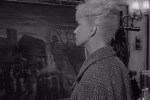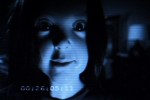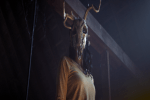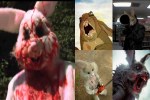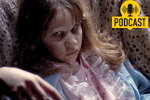Elizabeth Erwin and Dawn Keetley
The genesis for this special issue was a hotly debated Twitter (now “X”) thread in which the term “literary horror” was discussed. While some viewed the term as a way of parsing out mainstream potential, others viewed the term as a disparaging way to apply to books the “elevated horror” conversation taking place in horror film communities.
When we talk about horror literature, we’re talking about any and all written works designed to unsettle or frighten readers. It’s an intentionally wide umbrella with room to include literary award winners, pulp favorites, extreme gore, gothic classics, exploitation, cozy haunts, trope heavy “trash,” and everything in between. The common denominator in these differing approaches to the genre is that the horror elements are not a by-product of the story, but its central catalyst.
In recent years, efforts have coalesced to recover the “trashier” side of horror literature. Of course, one reader’s trash is another reader’s treasure, but, generally speaking, these titles tend to be objectively offensive, traffic in taboo, and/or published at an accelerated rate to capitalize on market demand. The 2017 publication of Paperbacks from Hell, a celebration of 70s and 80s horror novels curated by Grady Hendrix and Will Errickson, shone the light on titles specifically published to quench reader demand. Released in paperback form to be affordable and with stunning cover art designed to entice readers with the promise of a debaucherous read, these books traditionally have occupied the same spaces as low budget horror. In writing about the tension between trash cinema and high art, Joan Hawkins argues that it is “affect that characterizes paracinema as a low cinematic culture” (4). This intent to “thrill, frighten, gross out, arouse, or otherwise directly engage the spectator’s body” is similarly evident in horror literature and provides a potential point of distinction between these titles and ones whose horror aims are more cerebral (4).
Further recovery of these stories has come in the form of republishing efforts designed to make accessible titles that have long been out of print. Publishers such as Valancourt Books are recovering voices in horror that have been silenced for years:
“We’ve also republished tons of great classic horror fiction from the 70s and 80s, including novels that were big bestsellers at the time but later forgotten, like Robert Marasco’s Burnt Offerings and Joan Samson’s The Auctioneer. I think republishing these books is really important, since without them our understanding of 20th-century horror fiction is incomplete. As important and prolific as Stephen King has been, there is more to the genre besides him, and our reissues help readers rediscover that lost history of horror.”- James D. Jenkins, Valancourt editor (Rowe)
The incredible diversity and aesthetic and intellectual richness of Valancourt’s publications are helping to showcase horror literature’s importance ‘beyond King’ and beyond the often low expectations of horror literature held by the literary community. Steffen Hantke’s essay in this special issue, which takes up the recent reappraisal of fiction from the ‘horror boom of the 1960s – 1980s, asserts that, “At its best . . . there was always more to horror fiction during the 1980s than King, Straub, Rice, and Koontz.” Yes, indeed. Not surprisingly, three of the essays in this special issue take up recent Valancourt publications, two of which are precisely those reissues that make it clear how much more there actually was to horror’s ‘Golden Age’, including one of the Paperbacks from Hell series, 1980’s The Nest by Gregory A. Douglas, Bernard Taylor’s ‘low-brow’ 1982 folk horror novel, The Moorstone Sickness – and then the translated short stories of one of the best contemporary Italian horror writers, Luigi Musolino’s A Different Darkness (2022).
This special issue unambiguously pushes back on the framing of horror literature as somehow lesser than its categorical peers. Derivative works are part and parcel for any literary genre, and yet it has traditionally been horror and romance – two genres that explicitly engage with the body – that have served as the scapegoats for critics looking to draw lines between low-brow and high-brow fiction. But such distinctions are ultimately nebulous. Is Elizabeth Engstrom’s haunting meditation on the constraints of gender in 1985’s When Darkness Loves Us (another Paperback from Hill reissue) any less impactful than Charlotte Perkins Gilman’s “The Yellow Wallpaper” (1892)? Is the source of the horror in Peter Tonkin’s 1980 Killer (yes, another Paperbacks from Hell reissue) really all that different from Peter Benchley’s Jaws (1974)? Or, are the problematic castings of adolescent sexuality in Ken Greenhall’s Elizabeth: A Novel of the Unnatural (1976) really all that different from those found in Vladimir Nabokov’s Lolita (1955)? We argue that they are not – and that what ultimately remains in the popular culture zeitgeist sometimes has more to do with marketing than it does content.
This special issue ranges from the exploration of queer sexuality in a late nineteenth-century horror novella to explorations of creativity, ecological crisis, sexual taboo, trauma and grief in twenty-first-century horror fiction. The incredible span and diversity of the fiction taken up by the essays here – and the importance and complexity of the questions asked by that fiction – make it clear that horror literature may well be one of the most important of literary genres. And we may well be living through another boom, another golden era, of horror production.
Works Cited
Hawkins, Joan. Cutting Edge: Art-horror and the Horrific Avant-Garde. University of Minnesota Press, 2000.
Rowe, Adam. “How One Indie Press Is Resurrecting Long-Neglected Retro Horror Paperbacks.” Forbes, 27 February 2019.


